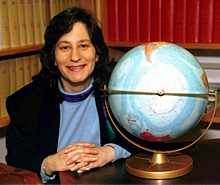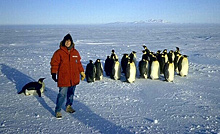Susan Solomon: Pioneering Atmospheric Scientist
- A Discovery of Global Significance
- Making of an Atmospheric Scientist
- Deciphering the Cause
- Advancing Understanding
- Using Science to Influence
- A Science "Ambassador"
A Discovery of Global Significance

Susan Solomon at her office in Boulder, Colorado. Click image for larger view.
NOAA senior scientist Susan Solomon (1956- ) has altered the course of atmospheric research through her pioneering role in the international scientific community’s efforts to discover the cause of depleted atmospheric ozone in the Antarctic, known as the ozone “hole.” Her research has also helped institute a global ban on the chemicals that destroy atmospheric ozone and, consequently, threaten human health worldwide.
The Making of an Atmospheric Scientist
Dr. Solomon first became enamored of science while watching such shows as the “The Undersea World of Jacques Cousteau.” But by high school she had switched her allegiance to the atmosphere when she earned third place in a national science contest by measuring the amount of oxygen in various gaseous mixtures. She studied chemistry at the Illinois Institute of Technology and then earned a doctorate at the University of California at Berkeley in 1981. She then went to work at NOAA’s Aeronomy Laboratory in Boulder, Colorado, where she has spent her entire professional career.
Deciphering the Cause of the Antartic Ozone Hole
Ozone is an uncommon but highly important form of oxygen. Most of it is concentrated in a layer of the stratosphere (the upper atmosphere) about 15 to 30 kilometers (about nine to 19 miles) above the Earth’s surface. This ozone layer filters the sun’s ultraviolet radiation. Without the protection of this filter, humans can suffer over exposure to ultraviolet radiation leading to increased levels of skin cancer, cataracts, and a weakened immune system. Depleted atmospheric ozone can also lead to reduced crop yields, disruptions in the marine food chain, and other harmful effects.

Most severe ozone depletion occurs in the polar regions. Measurements from a NASA satellite show the changes in the amount of ozone over Antarctica. Click image for larger view.
Deciphering the cause of the Antarctic ozone hole came from Solomon’s theoretical work and first-hand scientific observations. Her theoretical work showed that reactions of man-made chlorine compounds occurring on the surface of polar stratospheric clouds could play a defining role in forming the Antarctic ozone hole. This has since been firmly established as the key to Antarctic ozone depletion.
Besides her seminal theoretical studies, her key measurements helped develop the scientific understanding needed to confirm the theory of ozone depletion. In particular, in 1986 and 1987 she led expeditions to Antarctica and personally carried out the first observations of chlorine dioxide, which showed that its abundance there is about 100 times greater than predicted. This was the first direct evidence that pointed to chlorine chemistry as the cause of the Antarctic ozone hole.
Advancing Understanding of the Stratosphere
While Dr. Solomon’s work on polar ozone depletion stands as her “trademark” achievement, she has continued to develop key insights at the frontiers of understanding the stratosphere. She was first to suggest that chemical reactions similar to those found at polar latitudes could occur on the surface of sulfuric acid particles found in the atmosphere at mid-latitudes, particularly after volcanic eruptions. As in her polar ozone research, Dr. Solomon combined her theory with real-world observations. She measured atmospheric chlorine dioxide following the 1991 Mt. Pinatubo eruption in the Philippines. Those observations and the measurements of record low ozone after the eruption confirmed her hypothesis. This combination of key theoretical and experimental contributions is unique among stratospheric researchers.
Using Science to Influence and Guide Public Policy
No ivory tower scientist, Dr. Solomon works at the intersection of science and public policy. She is one of two co-chairs of the Science Working Group I of the Intergovernmental Panel on Climate Change, an organization that advises governments and industry on climate-related issues. She developed a new method for evaluating the ozone depletion potentials used as a scale for regulating compounds that damage the ozone layer. Her method greatly strengthens the understanding and validity of these key indices. She is the leading researcher involved in evaluating the impacts of proposed substitutes for ozone-depleting compounds known as chlorofluorocarbons and halons. And, she has served as lead author in international assessments on ozone and climate, which are used by international leaders as the scientific foundation for their decisions on how to protect the Earth's ozone layer and climate. Her involvement in such endeavors demonstrates her commitment to science in the service of humankind.
A Science "Ambassador" with Many Achievements

Dr. Susan Solomon and some new friends on Antarctic expedition in 1987 near McMurdo Station. Click image for larger view.
The nation and the world have recognized Dr. Solomon for her scientific achievements. She has received many national and international awards including the National Medal of Science, the Montreal Protocol Tenth Anniversary Award from the United Nations Environment Programme, and the prestigious Blue Planet Prize in 2004. She is a member of the U.S. National Academy of Sciences, the European Academy of Sciences, and the Academy of Sciences of France.
In addition to her service to science on the national and international level, Dr. Solomon is dedicated to fostering the interests of students and the general public in science. She is an enthusiastic and inspirational role model for women in science. She has advised students at all levels on pursuing scientific careers. As a NOAA senior scientist she has fostered the careers of several young women scientists who have flourished in her research group. Dr. Solomon has been a superb "scientific ambassador" through her achievements, discoveries, and service for NOAA, the nation, and humanity.









